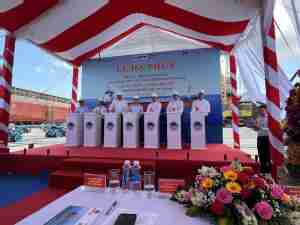Known as IYCAPS (Intermodal Yard Capacity Planning System), the software is now being offered for sale worldwide to ports, terminal operators and others who need to analyze intermodal rail yard operations.
"There is no other simulation software out there that allows you to predict intermodal yard capacity this simply and on a PC," said Udo Mehlberg, the Port of Tacoma's Information Technology Project Manager & Business Analyst. "There's no programming involved, and that's very important."
Competing intermodal yard modeling software products require as long as three to six months of data input to develop a reliable model and predict capacity. "Our software allows us to do it in two to four weeks," said Mike Zachary, the Port's Director of Planning and Logistics. "It's a plug-and-play type of modeling situation."
According to Carsten Boll, Director of the ISL's Planning and Simulation Systems Department, the Port of Tacoma's acknowledged leadership in on-dock intermodal operations makes it a natural development partner.
"Tacoma was a trailblazer with on-dock intermodal operations in the 1980s and is known in the industry for a lack of congestion that makes it comparatively easy to move cargo in and out," he said.
Boll predicted that IYCAPS will find a strong market among West Coast ports and companies that operate intermodal yards both on the coast and inland. "The Port of Tacoma sees it as a very useful tool," he said.
"And we have a good reference in Tacoma, because when you come to a new customer, one of the first questions is 'Where is it being used?'"
The IYCAPS software already has been used to successfully determine the capacity of intermodal yards at Tacoma's Pierce County Terminal and at Washington United Terminals. It has been used to plan a doubling of the capacity of the on-dock yard at Pierce County Terminal, the Northwest home of Evergreen Marine, Hatsu Marine and Italia Marittima.
In addition to determining maximum throughput, the software also can predict the effect that enhancements such as new equipment or physical modifications will have on an intermodal yard. "There are many variables that we can manipulate," said Brian Mannelly, the Port's Manager of Terminal Planning and CADD Services. "For example, we can manipulate seasonality - we have times when volumes are higher than others ' and see how variations in the peaking cycles change the output."
The software also is unique in its ability to determine train length.
This is based on the number of containers and the types of train cars that will be used to carry them. "There are many types of rail cars and each has a different length or capacity in TEUs," Mehlberg explained.
"The combination of cars and capacities can be very complex, and knowing the length of a train is important when you have a limited number of tracks."
Mehlberg said that beneath IYCAP's easy user interface is a "highly complex" technical product. In the simplest of terms, it creates a model by quantifying intermodal yard activity in three areas:
- Arrival of cars and trains from Tacoma Rail or from hubs at the Port;
- Internal yard operations, trackage, productivity and waiting times; and
- Train building and movement to the mainline railroad.
Zachary said the software has undergone extensive testing by both the Port and ISL, and Mehlberg and Mannelly have added numerous enhancements during the development phase.
"It's now ready for prime time," Zachary declared.









